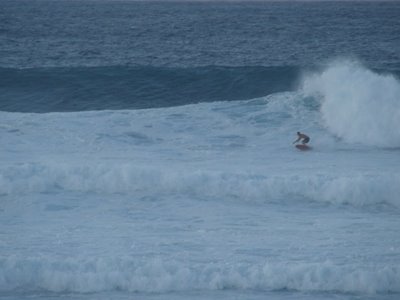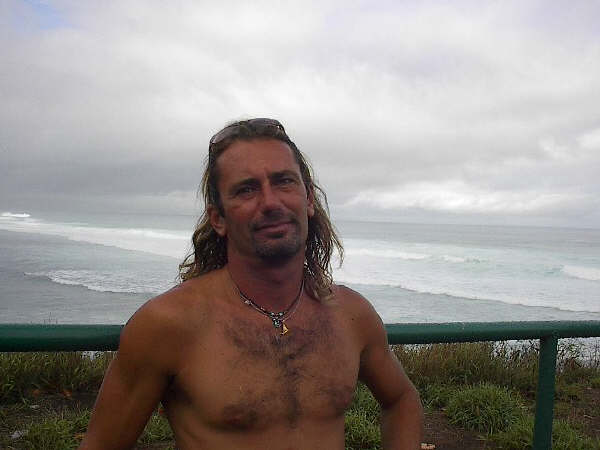I heard that Hookipa was quite a show. Kauli (just arrived on the island, Robin) destroyed his favorite board on the rocks (I'm sure Taboul is already shaping another good one for him) and Laird surfed standing up with the paddle. He's just not normal. He's another living legend. I'm not gonna comment his personality 'cause I don't know him well enough, but what he does is absolutely legendary.
Time for a photo. Hookipa at sunset. If the wave this guy is riding is almost double overhead, how big is the one behind?

Today an Italian chap asked me why the waves were messy. Check my blog, I said, I just wrote something about it last week. Time to post it.
What makes the waves in the ocean is the wind. The area over which the wind blows is called the fetch.
When the wind first starts blowing over a hipothetycal flat fetch, it creats small ripples because of the friction of the the air molecules sliding over the water molecules. The longer and the stronger the wind blows, the bigger the ripples get and the more they spread apart. In order for the waves to get even bigger, the fetch should be extremely long, and/or the wind should follow the waves as they are generated. This last condition is possible (at least temporarely) and it's called captured fetch. A captured fetch happens when the storm moves in the same direction of a fetch, so that the wind keeps pushing the same waves following them.
Other things you want to know:
- the stronger the wind, the bigger the waves
- the longer, wider and long lasting the fetch, the bigger the waves.
What if there were 120 knots of wind over a huge fetch for a whole month? Would that generate a 100 foot swell? No, because once the waves are big enough, the wind can't make them grow anymore, because the waves themselves act as a shade for the wind that can only hit the crest. That's when the power of the wind only vaporizes the crest of the big waves without making them grow more. But that doesn't happen too often...
Once a swell has been generated and the wind died or the waves travelled outside the fetch, here's what happens.
In a swell there are waves of different period. The period is the distance in seconds between two crests. The more the waves are exposed to the wind, the more they get spread apart and the period increases. But at the same time, newly generated waves of short period keep adding on top of the long period one. The waves with longer period travel faster and last longer. That's why if the fetch was too close to the shore, the waves will be disorganized. In other words, the more a swell has to travel to get to the shore, the cleaner it will be. But the travelling not only will filter out the short period waves, but it will also diminuish the energy of the longer period ones.
The hawaiian islands sit around 20 degrees latitude north. That means that if there were two identical storms spinning at 60 degrees north and 60 degrees south, both with identical fetches aimed towards Hawaii, the resulting north swell would be bigger than the south one, but the south ones would be cleaner. That's because the south one would have had to travel 40 degress more (the ones across the equator) and would have lost some global energy, but would have had the chance to get rid of most of the short period energy.
Since the longest period waves travel faster, they are going to be the first ones to get to the shores. In other words, the start of a swell is usually the cleanest part of it (unless there's onshore wind, of course), even though the biggest part could be still to come. The forerunners of a big swell here in Hawaii can have 20-24 seconds period, but the main energy is usually focused 24 hours later in the 14-17 seconds period.
Waves of longer period also have the ability to amplify their size when they hit a shallow bottom that will make them break.
Let me clarify this. I read somewhere that a wave start feeling the bottom (and hence eventually break) when the bottom is 1.3 times the size of the wave. In other words, a wave that is registered by a buoy to be 2 feet in deep water, will start growing and ready to break when it hits a bottom that is 2.6 feet deep. Or a 10 feet baby will start sensing the bottom as soon as it hits a 13 feet deep reef.
Said this, let's go back to the waves with longer period. A very nice analogy I read somewhere else, is the following: think about the action of the wind on the ocean surface like when you want to make a pizza out of a ball of dough. The more you push, the thinner the pizza gets. You can get a very large and thin pizza if you keep pushing for a long time. Same thing happens with the wind (your hand) and the water (the dough). When a long period wave start sensing a shallow bottom, it's like all that dough will get compressed back together again, and even if the wave was small (thin dish) in open ocean it may grow a lot when it's time to break.
Other factors that might change the course of a swell are:
- other fetches of wind that would blow in the same direction (clearly amplifying the energy of the swell), opposite direction (clearly dimishing the energy) or cross direction (not sure doing what).
- other swells (the effects are as above)
- land (a chain of island will filter some energy out of the swell for example). Point breaks, for example, are surf spot in which a swell hits a point of land and then wraps around the point. Honolua Bay is the best example in Maui (probably the only one too, since all the other waves are mostly reef breaks with a few beach breaks). The cool thing about point breaks is that if the swell is not a clean one (again, that means waves of different period overlapping), the point break will clean it up. Only the longer period waves, in fact, will have enough energy to wrap around the point and the waves are going to be much cleaner.
This is the end of this little effort. I want to underline that the mechanisms that rule the way waves are generated and travel are extremely more complicated than what I tried to simplify and some of them have not even been understood yet. But hopefully this little knowledge will help some of you understand waves a little better.
It's quarter past eight and I'm going to sleep because tomorrow I want to go surf one of my favorite waves in Maui very early. If it's big enough, it might be going off...
In bed at 8.20 pm to go surf at dawn. What an awesome thing!
Cheers.









3 comments:
wow... to print and keep on my pocket.. of my wetsuit! A SW swell is coming and you could help me on havong more fun... who knows?
congrats
Pretty impressive waves! Nice to hear that Kauli is now getting into gear for the upcoming event. I guess the whole community must be ready now. Lets hope for wind and waves! Hope your dawn patrol was a success.
Lim, since I started windsurfing metereology has always appealed me. Being an engineer, I need to know how thing works... I can't just wait there for them to happen.
I read many different books, all quite technical. The last one I read was at the same time the best and simplest, at least to understand the waves. It's called Surf science and it's written by Tony Butt (quite a name!) and Paul Russell. Alison Hodge publisher.
I'm going to quote a joke from it:
"What's the prediction for Saturday?" asks a surfer to another surfer
"Flat"
"Thank goodness for that, I've got a wedding on Saturday and I can't go surfing!"
"Who's wedding is it?"
"Mine"
You think it's a joke... if I ever gonna get married, the date will be decided quite at last moment after having checked all the available forecasts...
Hey. a friend of mine just sent me an an email with an attachment called:"wavephysics.pdf". I haven't read it yet, but I can forward it to whoever interested. It's a little more than 4MB. Send me an email if interested.
Nico, I forgot where're you from!
Robin, I slept 10 hours (must have been all those waves I caught), so I missed the dawn patrol, because some wind was already on it when I was ready. Not too bad, I went sailing on my longboard again...
Post a Comment